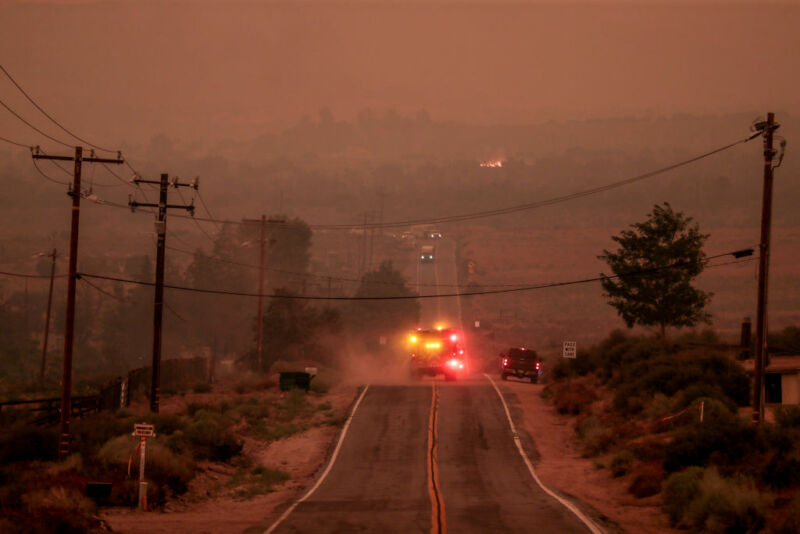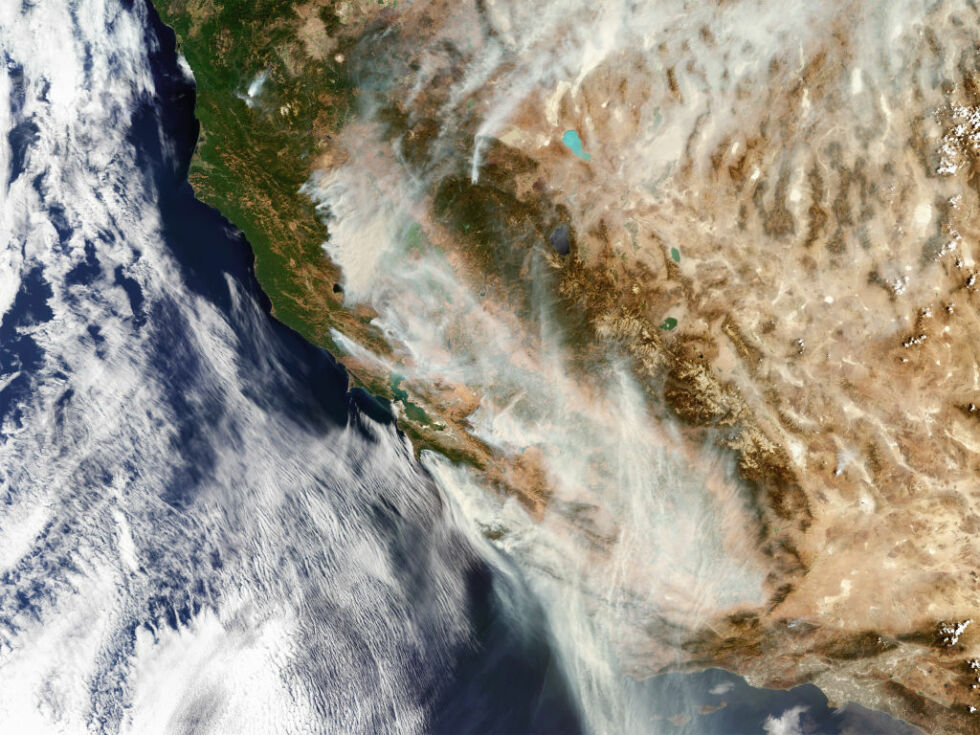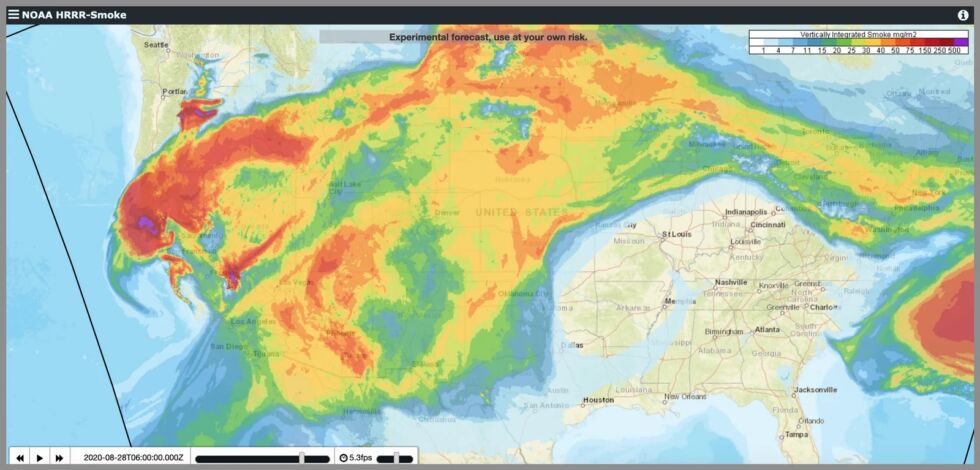
The West Coast’s wildfire crisis is no longer just the West Coast’s wildfire crisis: As massive blazes continue to burn across California, Oregon, and Washington, they’re spewing smoke high into the atmosphere. Winds pick the haze up and transport it clear across the country, tainting the skies above the East Coast.
But what are you breathing, exactly, when these forests combust and waft smoke near and far? Charred trees and shrubs, of course, but also the synthetic materials from homes and other structures lost in the blazes. Along with a variety of gases, these give off tiny particles, known as PM 2.5 (particulate matter 2.5 microns or smaller), that weasel their way deep into human lungs. All told, the mixture of solids and gases actually transforms chemically as it crosses the country, creating different consequences for the health of humans thousands of miles apart. In other words, what you breathe in, and how hazardous it remains, may depend on how far you live from the Pacific coast.

When vegetation catches on fire, it releases a whole lot of carbon in many forms. The sooty stuff you can see is known as black carbon. The major components you can’t see are carbon monoxide—obviously very toxic—and carbon dioxide. When trees absorb carbon dioxide from the atmosphere, they sequester it in their tissues and release oxygen. When those trees catch on fire, that CO2 goes right back into the atmosphere.
Scientists have been sampling wildfire smoke in the atmosphere with a special plane loaded with a bevy of instruments connected to little tubes that stick out of the aircraft. “Basically, it’s my laboratory,” says Rebecca Hornbrook, an atmospheric chemist at the National Center for Atmospheric Research. These instruments measure conditions like humidity and temperature, along with particulate matter and carbon dioxide, benzene, and formaldehyde—the last two are quite toxic. “By combining all that data together, we’re able to get a really full picture of what’s going on chemically inside the plume, both in the gas phase and in the particle phase,” she says.
Hornbrook has been exploring how the chemical components of wildfire smoke change the longer they remain in the atmosphere. Benzene, a highly flammable compound that easily evaporates into the air, can stick around for two weeks. Formaldehyde lasts only a day or two. Other components may last only a few hours, so Hornbrook can actually watch their levels decrease as she flies through a smoke plume. The smoke’s trip across the country takes four or five days, but it will then linger in the atmosphere on both coasts—and the most persistent components will survive the journey from coast to coast. “Some of those harmful chemicals remain in the smoke, remain in the atmosphere, far, far downwind from where they’re emitted,” Hornbrook says. “Clearly the most toxic environment is very close to the fires where the concentrations are at levels that can be harmful.”
As the smoke plume travels through the atmosphere, “the heavier particles are going to start to fall out as time moves on,” says Rebecca Buchholz, an atmospheric chemist at the National Center for Atmospheric Research. “But then those sticky, partially burnt carbon gases are going to start to coagulate and become more particles again. So you’re losing particles out of the smoke, but you’re also gaining particles as the air processes through time.”
Another atmospheric nasty we’re all too familiar with forms as well: ozone, which inflames your airways. “Ozone requires carbon-containing gases, nitrogen-containing gases, and sunlight,” says Buchholz. “And so the more processing time you have, the more ozone is going to get created in that smoke plume.”

By the time it reaches the East Coast, a California smoke plume will have changed in a number of ways: Because it’s spent so much time aloft, the bigger particles have fallen out, but new particles will have formed. And because the cloud has spawned ozone, “it can be extremely impactful if you already have some health condition, let’s say asthma,” says Tarik Benmarhnia, a climate change epidemiologist at the UC San Diego’s Scripps institution of Oceanography and School of Medicine.
The solid stuff in wildfire smoke may also contain nasties. “Some particulate matter has more heavy metals than others,” says Mary Prunicki, director of air pollution and health research at Stanford University’s Sean N. Parker Center for Allergy Research. “Lead for example, or cadmium. There’s also other types of cancer-causing toxins. There’s things like PAHs—polyaromatic hydrocarbons,” which are found in fossil fuels. Keep in mind that when a wildfire tears through a residential neighborhood, it’s burning through the synthetic materials that make up homes, cars, and everything else in the built environment. “I think a lot of times we don’t know, when we’re talking about residential areas burning, how much more toxic it is to human health,” Prunicki adds.
With this handy map, you can actually see a forecast of where the smoke will end up. On the left side of the map, click “Vertically Integrated Smoke” to see what’s loading the East Coast atmosphere right now. (Red indicates high levels, blue means low.) The “Surface Smoke” option shows what you’d actually be breathing. As you can see, the latter is snaking a plume of bad air quality all the way to the Midwest, though at the moment not much of it is reaching the ground along the Eastern Seaboard. Which is not to say that it won’t—the weather could change and push the stuff down to ground level, at which point air quality will suffer.
Meanwhile, the West Coast has its own ozone problems because smoke has been recirculating through the region. “It’s staying in the same place, and you’re getting the same pollution from yesterday,” says Buchholz. The more time that goes by, “the more this ozone can be produced with sunlight.”
It’s not helping matters that the West Coast has been suffering extreme heat as these fires have burned—indeed, this and other consequences of climate change are supercharging blazes, because hotter temperatures and drier brush are making wildfires burn more intensely. That heat leads to the formation of yet more ozone at ground level. Hot air rises, so the fiercer the wildfire, the higher it propels smoke into the atmosphere to be carried across the US.

Wherever the smoke lands, we know it won’t be good for human health. “There’s a lot of literature in air pollution research showing associations with PM 2.5 and different types of diseases, in addition to shortened life expectancy, throughout the world,” Prunicki says. Her own research confirms that wildfire smoke specifically leads to inflammation in the lungs. She and her colleagues studied teenagers in Fresno, California, which suffers from bad air quality in general, but also endures blasts of wildfire smoke from forested areas to the east. “We looked at a group that was exposed to a wildfire versus not, and there was an increase in some of the systemic inflammatory biomarkers,” Prunicki says. “So we know that the smoke itself will cause systemic inflammation.” This is unhealthy for anyone, much more so for people with asthma or other respiratory issues.
Prunicki has also found that wildfire smoke causes an immune gene to be turned down, specifically one that produces what are known as T regulatory cells. “And T regulatory cells are needed to kind of have a healthy immune system,” Prunicki says. “It’s a good type of immune cell, not an inflammatory type of immune cell.”
How all of this might interplay with Covid-19, a disease that in part attacks the lungs, is a bit tricky. For weeks, West Coasters have been heeding warnings to stay inside and keep their windows shut. If people aren’t going out, they’re cutting their exposure to the virus—but if they are going out, smoke inhalation might exacerbate their symptoms if they do catch it. “I don’t think we’ll see a huge increase in new infections from Covid,” says Benmarhnia, of UC San Diego. “Maybe the opposite, because people may stay more at home.”
“But then,” Benmarhnia adds, “even if we assume a stable incidence of new cases of Covid-19, we expect more severe symptoms, because of this kind of alteration of the immune system from PM 2.5 exposure.” Benmarhnia and his colleagues will be watching over the next few weeks to see if there’s a spike in severe cases as wildfire smoke continues to hover over the West Coast.
And Covid-19 won’t be the only bug that exploits smoke’s effect on the immune system—we’re coming up on flu season. So that’s a triple whammy: out-of-control forest fires, the Covid pandemic, and influenza. “All of those things on their own can take a big hit to the immune system,” says Prunicki. “But compiled, I honestly don’t think we’ve experienced anything like that before.”
This story originally appeared on wired.com.
https://arstechnica.com/?p=1707853

